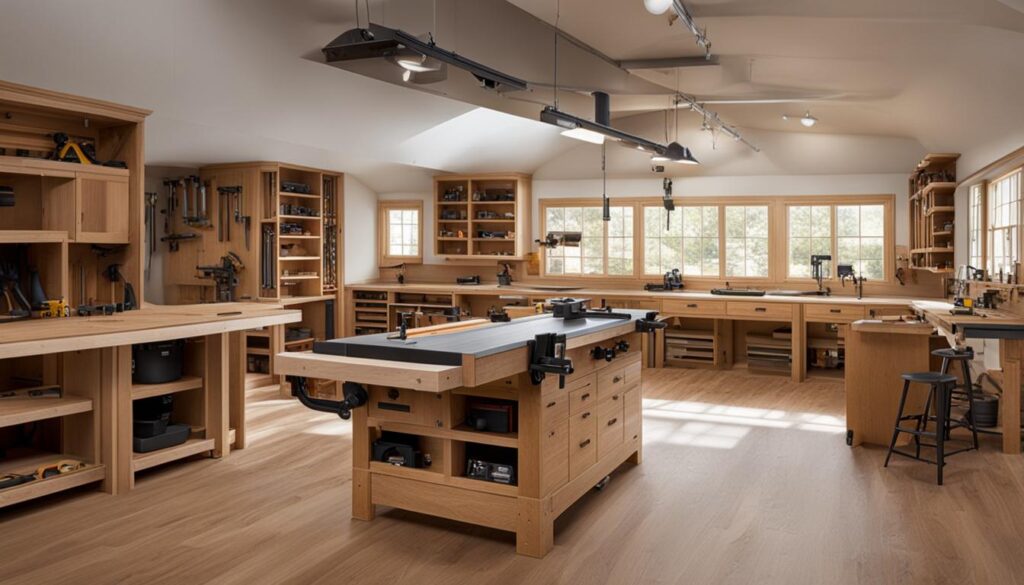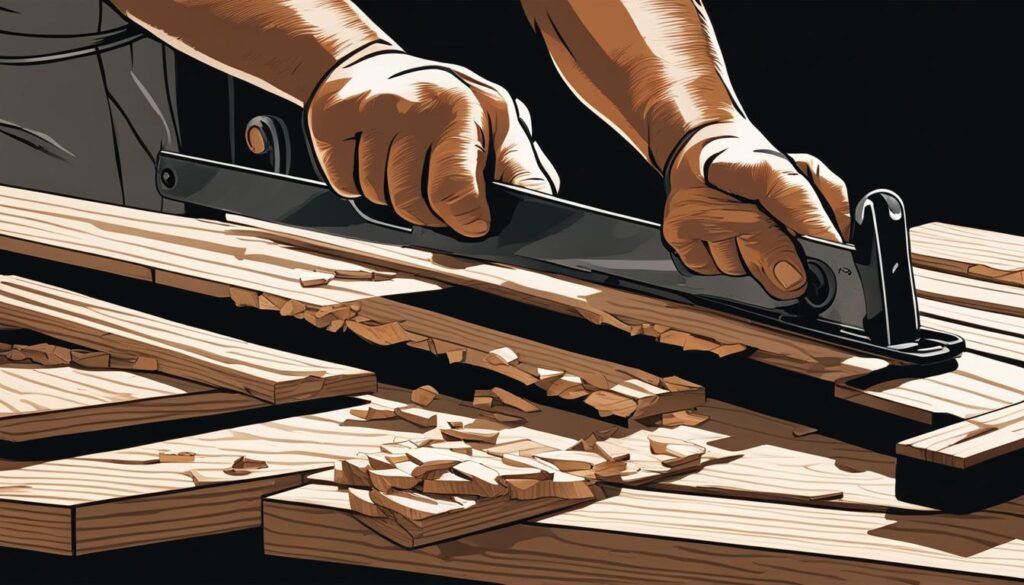We may earn money or products from the companies mentioned in this post.
As a woodworking enthusiast, having an ideal layout for your woodworking shop is crucial to optimizing efficiency and enhancing creativity. A well-designed layout ensures that you have enough space to work in and that your tools and materials are well organized and easily accessible.
When designing your woodworking shop layout, there are key factors to consider to create an efficient and productive workspace that suits your needs. From the size of your space to the position of your tools, every detail counts in ensuring that your shop is functional and professional-looking.
Key Takeaways
- Having an ideal layout for your woodworking shop is crucial for optimizing efficiency and enhancing creativity.
- A well-designed layout ensures that you have enough space to work in and that your tools and materials are well organized and easily accessible.
- When designing your woodworking shop layout, key factors to consider include the size of your space, the position of your tools, and the overall functionality of your workspace.
- Maximizing the use of space in your woodworking shop is essential, both for creating a spacious environment and for ensuring that your tools and materials are within easy reach.
- A professional woodworking shop setup is essential for promoting a productive workflow, optimizing lighting and ventilation, and setting up dedicated work areas.
Key Factors to Consider in Woodworking Shop Layouts
In designing your woodworking shop layout, there are several factors to consider. By taking the time to plan and organize your workspace, you can create an efficient and productive environment that suits your needs.
Size and Shape
One of the first things to consider when designing your woodworking shop layout is the size and shape of your workspace. Depending on the size of your shop, you may have limited space to work with. However, by utilizing creative solutions such as building upwards or using wall-mounted storage, you can optimize the use of your available space.
You should also consider the shape of your workshop, taking into account any irregularities such as corners or pillars. These can affect the flow of your workspace, so it’s important to plan around them.
Workflow
Another key factor to consider when designing your woodworking shop layout is the workflow. This refers to the movement of materials, tools, and yourself throughout the workspace. By planning a logical flow, you can optimize your efficiency and reduce unnecessary movements.
For example, you may choose to place your workbench near your lumber storage area to minimize the distance you need to carry materials. Additionally, you could consider grouping similar tools together in order to streamline your workflow and reduce setup time.
Lighting and Ventilation
Good lighting and ventilation are essential factors to consider in any woodworking shop layout. Inadequate lighting can lead to eye strain and errors, while poor ventilation can cause health issues from inhaling sawdust or fumes from finishes.
When planning your woodworking shop layout, ensure that you have ample natural lighting or artificial lighting that simulates natural light. Additionally, you should have a ventilation system in place, such as a dust collection system, to keep the air in your workspace clean and safe.
Storage and Organization
Effective storage and organization are key to maintaining an efficient woodworking shop. By keeping your tools and materials organized and easily accessible, you can reduce setup time and avoid frustration.
Consider incorporating storage solutions such as cabinets, shelves, and drawers into your woodworking shop layout. You could also label your tools and materials to make it easy to find what you need quickly.
Flexibility and Adaptability
Finally, when designing your woodworking shop layout, it’s important to consider the flexibility and adaptability of your workspace. Your needs may change over time, so it’s important to plan for future growth and changes.
This could involve leaving some open space in your layout for future expansion, or incorporating easy-to-move workstations or equipment. By planning for flexibility and adaptability, you can ensure that your woodworking shop layout remains functional and efficient over the long term.
Designing a Spacious and Organized Woodworking Shop
Creating the ideal woodworking workshop design can be challenging, especially when working with a small woodworking shop layout. However, with the right strategies, you can maximize the space available and create a spacious and organized woodworking shop that suits your needs.
Maximizing Space
When designing a small woodworking shop layout, it is essential to think creatively about how to use the space most efficiently. One strategy is to use wall space to store tools and materials. Wall-mounted storage solutions such as shelves, pegboards, and cabinets can free up floor space and make your tools more easily accessible.
Another strategy is to use mobile workstations. Rolling carts and workbenches can be used as needed and stored out of the way when not in use. This approach maximizes the flexibility of your space and allows you to adapt to different project needs.
Organizing Your Tools and Materials
An organized woodworking shop is essential for optimizing efficiency and productivity. Below are some tips for keeping your tools and materials in order:
- Use tool racks and holders to keep tools organized and within easy reach
- Label drawers, cabinets, and containers to help you locate materials quickly
- Group similar tools and materials together in specific workstations for easy access and workflow
- Invest in high-quality storage solutions for your tools and materials to ensure they are protected and last longer
Ensuring Adequate Lighting and Ventilation
Good lighting and ventilation are essential for creating a comfortable and safe woodworking environment. Natural light is ideal, but if that isn’t an option, invest in high-quality task lighting that illuminates specific workstations and areas. It’s also important to ensure good airflow and ventilation to remove dust and fumes. Install a ventilation system or use a high-quality air purifier to maintain good air quality and prevent health issues.
By considering these tips for designing a spacious and organized woodworking shop, you can create a workspace that promotes creativity and productivity, no matter the size of your space.
Creating a Professional and Optimal Woodworking Shop Setup
Designing a professional woodworking shop layout is essential to optimize productivity and create an ergonomic work environment. The layout should be designed in a way that promotes a smooth workflow, minimizes time wastage, and enhances creativity.
Positioning Tools
One of the most critical aspects of a professional woodworking shop layout is the positioning of tools. The layout should prioritize accessibility and ease of use, ensuring that the most frequently used tools are conveniently located near your work area. Consider using tool cabinets, racks, or pegboards to increase efficiency and organization. This strategy will save you time and energy, allowing you to focus more on your projects.
Setting Up Dedicated Work Areas
Creating a dedicated work area is another crucial component of a professional woodworking shop setup. This area should provide ample space for you to work comfortably and without distractions. Consider including a sturdy workbench with sufficient lighting for optimal visibility. Ensure the work area is equipped with all the necessary tools and equipment, including power outlets, dust extraction systems, and safety equipment.
Optimizing Lighting and Ventilation
Good lighting and ventilation are critical to creating a professional woodworking shop setup. Lighting should be sufficient in intensity and be directed at the work area, providing ample visibility. Natural light is an excellent option for woodworking shops if sufficient light is available. Ventilation is also essential as it prevents health hazards that may be caused by dust, fumes, and other harmful substances. Consider installing a dust extraction system to keep your shop clean and healthy.
Layout Comparison Table
| Layout Type | Advantages | Disadvantages |
|---|---|---|
| U-shaped layout | Optimal workflow, promotes space efficiency, and provides easy access to tools and equipment. | Requires a larger workspace, which may be impractical for small shops. |
| Straight-line Layout | Provides a simple and straightforward workflow, ideal for small shops. Requires less space than the U-shaped layout. | May not be practical for larger shops as it may lead to grouping of tools. |
| L-shaped layout | Optimizes space usage, provides a simple workflow, and easy access to tools and equipment. Suitable for both small and large woodworking shops. | May create blind spots, requiring additional lighting and ventilation. |
“A well-designed woodworking shop layout saves time, reduces stress, and promotes creativity.”
In conclusion, a professional woodworking shop layout is vital to optimize productivity and enhance creativity in your workspace. Designing a layout that prioritizes the positioning of tools, dedicated work areas, and proper lighting and ventilation can help you create a productive and ergonomic work environment. By considering the advantages and disadvantages of different layout types, you can choose the ideal layout that suits your woodworking shop’s size, needs, and budget.
Conclusion
In conclusion, having an ideal woodworking shop layout is critical to maximizing efficiency and enhancing creativity in your workspace. By considering key factors such as workflow, tool accessibility, and safety, you can design a layout that suits your needs and preferences.
Creating a spacious and organized woodworking shop is also essential for promoting a productive workflow. By optimizing space utilization and effectively organizing tools and materials, you can ensure an efficient and clutter-free workspace.
Professionalism is Key
One of the essential elements of a woodworking shop layout is creating a professional and optimal setup. By positioning tools in a way that promotes an organized workflow, dedicating work areas, and ensuring proper lighting and ventilation, you can create a space that is conducive to high-quality woodworking projects.
Remember, your woodworking shop is a reflection of your professionalism and attention to detail. By implementing these layout ideas, you can elevate your projects and take your woodworking skills to the next level.
Thank you for reading, and we hope this guide has been helpful in guiding you towards the ideal woodworking shop layout for your needs!
FAQ
Why is having an ideal woodworking shop layout important?
Having an ideal woodworking shop layout is important because it can optimize efficiency and enhance creativity in your workspace. A well-designed layout ensures that tools, materials, and workstations are easily accessible, making it easier to complete projects and maintain a productive workflow.
What factors should I consider when designing my woodworking shop layout?
When designing your woodworking shop layout, consider factors such as the available space, the type of projects you will be working on, the number of tools and equipment you have, and the workflow that suits your needs. It’s important to create a layout that allows for efficient movement and minimizes any potential safety hazards.
How can I maximize the use of space in my woodworking shop?
To maximize the use of space in your woodworking shop, consider using vertical storage solutions, such as shelves and wall-mounted tool racks. You can also invest in mobile workbenches or folding tables that can be easily stored away when not in use. Additionally, organizing tools and materials into designated storage areas can help create a more spacious and efficient workspace.
What are some tips for creating a professional woodworking shop setup?
To create a professional woodworking shop setup, consider positioning your tools and equipment in a way that promotes a smooth workflow. Set up dedicated work areas for different tasks, such as cutting, sanding, and assembly. Additionally, ensure that your shop has proper lighting and ventilation to create a comfortable and safe working environment.
How can implementing these layout ideas improve my woodworking projects?
Implementing these layout ideas can improve your woodworking projects by increasing efficiency and promoting creativity. A well-organized and optimized workspace reduces time spent searching for tools and materials, allowing you to focus on the task at hand. It also provides a conducive environment for brainstorming and experimenting with different woodworking techniques, leading to better results and a more enjoyable woodworking experience.
Affiliate Disclosure: This post may contain affiliate links. If you purchase through our link, we may receive a small commission, but at no additional cost to you. For more information, please see our Disclosure statement.



